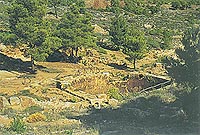

The silver (or strictly silver-bearing lead) mines in the
Laurion district of south Attica were an important source of
wealth concentration for Athens, from the time of Themistokles to
the days of Demetrios of Phaleron.
Laurion silver started to be used for minting the Athenian
coinage after the 520s B.C.
 |
A lessee's only outgoings were the hire of slaves and their minimal upkeep. By using a labour force of this sort the cost of revenue could be kept low and greater returns on investment achieved. In this way there was greater profit, both for wealthy private lessees and, in the form of prospecting rights and taxes, for the state. |
The twenty-fourth part of the revenue from any mine, irrespective of the length of lease, belonged to the city of Athens. The claims might belong to private individuals, but whatever minerals were dug up at Laurion were the property of the polis. Indeed it is very probable that the polis itself owned a good many acres of workable land. Be this as it may, no private individual was able to work a mine unless (after first putting down a sum of money) he was given the right to do so, by the polis. Rights might also be given to groups of private persons.
Should a lessee be unable to pay his rent, no action was taken against him - or at any rate no legal action. If on the other hand he was found guilty of shifting any of the posts that secured the mine or propped up the gallery roof, he was liable to the death penalty, his estate being forfeit and distributed among the [Athenian] citizens. This law was brought in not so much to protect the lives of the workers in the galleries - they were slaves - as to keep mining operations running smoothly.
 |
 |
| | introduction | landowning-farming | trade | mines | | |||
| | state welfare | liturgies | private property | | |||
| |||